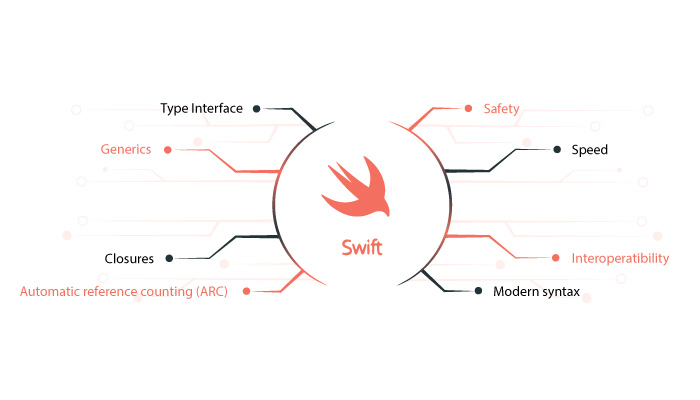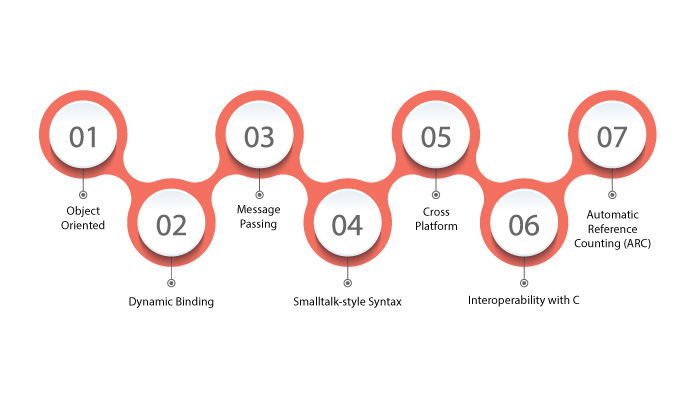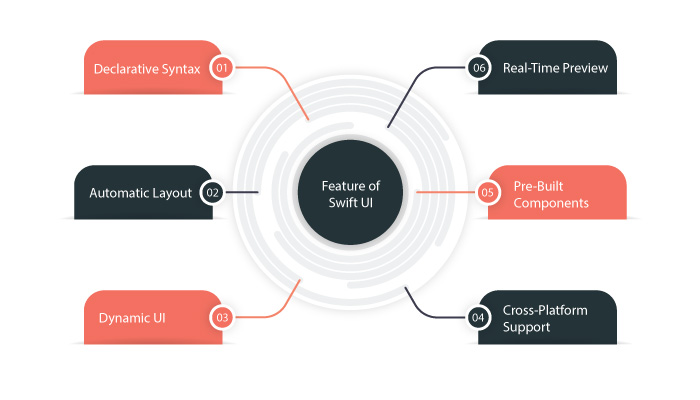Are you confused between Swift vs Objective C vs Swift UI?
Well, you aren’t the only one. Though it goes without saying that objective C and swift programming languages are two primary choices for iOS App development, choosing between these technologies can be pretty difficult.
“A tap is a zero-length swipe.”
― Apple Inc.
Therefore, if you are interested in iPhone app development this blog is for you. Here, we shall be going through all you need to know about Swift, Swift UI, and Objective C head-to-head.
Wth this being said, let’s get right into it, starting with:
(Swift UI vs) Swift vs Objective C: 101
What is Swift? Programming Language For iOS App Development
if you know anything about iOS app development, you are familiar with Swift. According to Apple, there are over 600,000 apps available on the App Store that have been built with Swift.
Moreover, The TIOBE Index, which ranks programming languages based on their popularity, currently ranks Swift as the 14th most popular language in the world
For those who aren’t familiar with it, Swift is an open-sourced programming language. Coming from Apple, the technology is can be used to built for various platforms. This includes:
- macOS
- iOS
- watchOS
- tvOS
“My goal for Swift has always been, and still is, total world domination,”
Chris Lattner, the creator of Swift
Here’s an interesting fact about Swift vs Objective C:Apple created Swift programming language almost a decade ago in 2014 to replace Objective C.
So, you know, this programming language has got something over Objective C, as we will find out later down the line.
Speaking of which, this is an easy-to-learn programming language, it’s safe and super fast! And when it comes to the coding part, you can see that it has modern syntax.
But how is it “modern” ? Well, it’s because the syntax is concise and easier to read.
With all of this out of the way, it’s time to look at the features of swift programming language in the section below.
Feature of Swift Programming Language

To better understand this programming language and how it performs in the Swift vs Objective C debate, let’s look at some of its top features.
· Safety
Swift has built-in features that help developers avoid common programming errors, such as optional. This allows developers to handle situations where a value may be missing or nil.
· Speed
The programming language is designed to be a fast language. And with a high-performance compiler, it can optimize code for maximum speed.
· Interoperability
Swift is designed to work seamlessly with existing Objective-C code, making it easy to use in existing codebases and with Apple’s frameworks.
· Modern syntax
Again, this solution has a modern and concise syntax that is easy to read and write. This makes it a popular choice for developers of all skill levels.
· Automatic reference counting (ARC)
Swift automatically manages memory usage. Thus, reducing the risk of memory leaks and other memory-related issues.
· Closures
Closures are a powerful feature of Swift. This feature allows iOS app developers to pass functions around as variables or arguments. It makes it easier to write asynchronous and event-driven code.
· Generics
The language supports generics. For those who don’t know generics is the way of writing code independent from the specific type being used.
This allows developers to write code that can work with multiple data types, reducing code duplication and improving efficiency.
· Type inference
Again the programming language being a modern one, it can automatically infer the type of a variable or constant. This helps reduce the need for explicit type declarations and makes code more concise.
Pros And Cons of Swift For iOS App Development
| Pros | Cons |
| Supports protocol-oriented programming | Steep learning curve |
| High performance | Frequent updates and changes |
| Seamless interoperability | Limited support for other platforms |
| Modern and concise syntax | Limited libraries and tools |
| Growing and active community | Debugging can be challenging |
What is Objective C?
Objective C is ranked 22nd in terms of popularity among programming languages as per TIOBE Index.
Moreover, Objective-C is mentioned as one of the top languages for contributors in the Apple ecosystem, with approximately 60,000 active repositories on the platform.
Even though the use of Objective C is declining, it’s one of the more popular programming languages in the market.
For those who don’t know about this programming language, let us make the swift vs objective C debate easier for you.
This is an object-oriented programming language mainly used for software development mainly for Apple’s platforms.
Objective C was first introduced back in the 1980s by none other than Brad Cox and Tom Love. The language was later licensed by NeXT Computer Inc. A company Steve Jobs founded after his departure from Apple.
As such, the language is actually a subset of Programming Language C.
Moving on, what makes this platform stand out from the rest is concepts like classes, inheritance, and dynamic binding. Apart from this, it also has a Smalltalk-like syntax for sending messages to objects.
Moving on, let’s look at the top features of this platform below:
Feature of Objective C

Objective C has some of the best programming languages especially dedicated to Apple solution development. Therefore, you can expect this language to have some great features. Some of these are, as mentioned below:
· Object-Oriented
One of the biggest advantages it has in objective c vs Swift for ios development debate is, it’ objective C allows you to define classes, create objects, and use inheritance, polymorphism, and other object-oriented concepts.
· Dynamic Binding
Here the method “dynamic binding” calls are resolved at runtime. Meaning the method to be called is determined at runtime based on the object being referred to.
· Message Passing
Again, method calls are done via message passing. Since the message is sent to an object, requesting an action, it’s way more natural and promotes intuitive coding.
Smalltalk-style Syntax
This programming language’s syntax is similar to Smalltalk. Meaning it is a simple and expressive programming language. This syntax is used for sending messages to objects, which allows for concise and readable code.
Cross-Platform
Objective-C is cross-platform development enabled. Therefore, it can be used to develop software for macOS, iOS, and other Apple platforms, as well as other platforms like Windows and Linux.
Interoperability with C
C is a superset of C programming language. Consequently, developers here can use C libraries and code, making it easy to integrate with existing C-based systems.
Pros And Cons of Objective C For iOS App Development
| Pros | Cons |
| Mature language | Syntax |
| Interoperability with C | Steep learning curve |
| Dynamic runtime | Memory management |
| Wide range of libraries and frameworks | Not as popular as Swift |
What is Swift UI?
Swift UI is a tool that is growing pretty popular among iOS app developers and that too for good reasons.
It is a UI toolkit that was developed by Apple. The toolkit is designed specifically for building software for various platforms including iOS, macOS, watchOS, and tvOS.
The platform was introduced some 5 years after Swift alongside Swift 5 and Xcode 11. And ever since then, it has provided a declarative approach to building UI design for iOS apps.
Being a powerful tool allowing developers to describe the layout and behavior of their app’s UI using a simple and intuitive syntax.
This makes it easier and faster to build complex UIs, as the code is more concise and easier to read than traditional imperative code.
Feature of Swift UI

So, what are the feature that makes Swift UI stand out from the rest? Well, some of the top features of the platform are, as mentioned below:
· Declarative Syntax
This toolkit uses a declarative syntax, which means that you describe what you want your UI to look like, rather than writing code that directly manipulates the UI. Moreover, this approach makes it easier to read and write code and makes it simpler to reason about the behavior of your UI.
· Automatic Layout
With SwiftUI, you don’t need to worry about the manual layout and sizing of UI elements. The framework automatically handles the layout of your UI based on the rules you specify.
· Dynamic UI
This user interface development platform allows you to create dynamic and interactive UIs with ease. You can animate UI elements, create complex transitions, and respond to user input using simple and expressive code.
· Cross-platform Support
SwiftUI supports all Apple platforms, including iOS, macOS, watchOS, and tvOS. Thus, making it possible to build apps for multiple devices with a single codebase.
· Real-time Preview
The toolkit comes with Xcode integration capacity. This allows you to see a live preview of your UI as you build it, making it easy to see how your design changes will look on different devices.
· Pre-built Components
SwiftUI includes a library of pre-built UI components, such as buttons, sliders, and text fields, that you can use to quickly create a variety of UIs.
Pros And Cons of Swift UI
| Pros | Cons |
| The declarative syntax is easy to read and write | Limited backward compatibility with older OSes |
| Automatic layout and sizing of UI elements | Relatively new framework, with a learning curve |
| Cross-platform support for all Apple platforms | Limited customization options for some UI elements |
| Dynamic UI with built-in support for animations | Limited third-party libraries and resources |
| Pre-built UI components for rapid development | Not as performant as lower-level APIs in some cases |
| Real-time preview of UI during development | Limited support for certain complex UI scenarios |
Objective C Vs Swift Comparison
So, what are the major differences between Swift and objective C? Well, in this section of the blog, we shall be comparing object C vs Swift head to head covering different parameters. Therefore, with this said, let’s get right into it:
| Objective C Vs Swift Differences | ||
| Feature | Objective-C | Swift |
| Age | Developed in the early 1980s | Introduced in 2014 |
| Syntax | Uses C-based syntax with Smalltalk-style message passing | Modern, concise syntax with a focus on readability |
| Options | Not supported natively | Supports optionals to help prevent runtime errors |
| Memory management | Manual memory management required, with support for ARC | Automatic memory management with ARC |
| Error handling | Uses traditional error handling with @try, @catch, and @finally | Supports modern error handling with try, catch, and throw |
| Performance | Slower compared to Swift due to overhead and lack of optimization | Faster due to modern compiler and optimization features |
| Open source | Yes, open-sourced by Apple and available on GitHub | Yes, open-sourced by Apple and available on GitHub |
| Interoperability | Can interoperate with C and C++ code | Can interoperate with Objective-C code |
| Learning curve | Steeper learning curve due to complex syntax and memory management | Easier to learn due to modern syntax and automatic memory management |
Objective C Vs Swift Performance
Let’s talk objective c vs Swift performance.
Swift performance is much faster than objective C. Reason being that, Swift uses a “modern” compiler which is highly optimized for better performance.
In addition to this, the programming language has features like type inference. This helps reduce code execution overhead, greatly adding to the performance.
Objective C Vs Swift Syntax
Let’s talk about one of the most important factor when comparing objective C vs Swift i.e. Syntax.
Starting with Objective C, this programming uses a syntax that is heavily influenced by Smalltalk. On the other hand, Swift has a more modern syntax, as we discussed in the previous point.
All in all, swift gains the upper hand here.
Swift Vs Objective C Code Example
With this being said, let’s look at the example of code example of both of these programming languages in the section below.
Objective C:
NSString *myString = @”Hello, world!”;
NSLog(@”%@”, myString);
Swift:
let myString = “Hello, world!”
print(myString)
Swift Vs Objective C Speed
When it comes to speed, Swift is generally faster than Objective C.
This is because Swift is designed to be more efficient than Objective C, with features like optional and automatic memory management that help to reduce the overhead of code execution.
In addition to this, Swift uses a more modern compiler that is optimized for performance.
Swift vs Swift UI: What’s The Actual Difference?
Despite what it might seem from the name, Swift and SwiftUI are two totally different things.
They are as similar to Car and Carpenters.
Well, you see, swift is a programming language specifically designed around iOS app development. On the other hand, SwiftUI is a framework used to design the user interface of an application.
Therefore, Swift and SwiftUI work together seamlessly to create robust and visually stunning applications for Apple’s platforms.
Swift vs Objective C: Which One is Better for iOS App Development?
So, which is actually a better option Swift vs Objective C?
Well, while most might say both of them are better at their own place, we beg to differ.
The statistics show that over the years after the release of Swift, the use of Objective C has been decreasing rapidly. And it is expected that in coming years, Swift will completely take over the complete iOS app development industry.
Therefore, with this being said, we have come to the end of our blog.
FAQ
Objective-C is an object-oriented programming language that has been around since the 1980s, while Swift was introduced in 2014 as a modern alternative. Swift is easier to read and write than Objective-C and has better memory management, making it a more efficient and safer language.
Swift is easier to learn and write, has better performance, is safer, and has more modern features than Objective-C. Swift also has a simpler syntax that is more readable and maintainable than Objective-C.
SwiftUI provides a simpler and more intuitive way to build user interfaces than traditional interfaces, which can be more complex and difficult to maintain. SwiftUI also provides better performance and more flexibility in terms of layout and design.

Niketan Sharma is the CTO of Nimble AppGenie, a prominent website and mobile app development company in the USA that is delivering excellence with a commitment to boosting business growth & maximizing customer satisfaction. He is a highly motivated individual who helps SMEs and startups grow in this dynamic market with the latest technology and innovation.
Table of Contents












No Comments
Comments are closed.